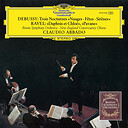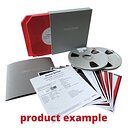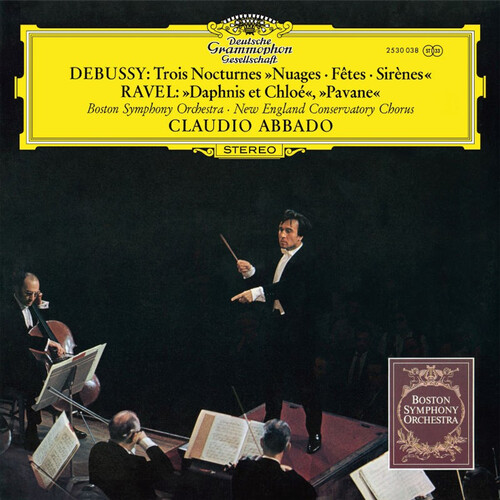Debussy Trois Nocturnes & Ravel Daphnis et Chloé Mastertape Studio Quality Reel To Reel Tape (2 Reels)
- Бренд
- HORCH HOUSE
- Артикул
- HH01.00.2
Master Quality Reel To Reel Tape!
Studio Master Copy with 2 Metal Reels!
The Boston Symphony Orchestra conducted by Claudio Abbado
Claude Debussy - Trois Nocturnes
The music of Claude Debussy has so often been paired with the art of the impressionist painters that it is almost upsetting to know that the composer himself, for a time at least, had other tastes. In 1899, shortly before the time he began work on the Three Nocturnes for orchestra, Debussy, in answering one of the then fashionable questionnaires on personal tastes, declared his favorite painters to be Botticelli and Gustave Moreau. A strange choice? Not when we remember that among the artistic currents of the time were pre-Raphaelitism and art nouveau, and Debussy was as much involved with them as with Impressionism. One thing in particular which he shared with the former was the idea of "the divine arabesque", the concept of art (and music) as a decorative pattern. This was a very new idea in Western music and it, as much as anything else, differentiates the music of Debussy from all that came before it.
Maurice Ravel -Daphnis et Chloé & Pavane
Maurice Ravel wrote his score for Daphnis et Chloé for Serge Diaghilev's Ballet Russe on a commission proferred in 1909. Due to a horrendous series of disagreements, however, involving Ravel, Diaghilev, Fokine the choreographer, Nijinky the dancer, and Bakst the stage designer, the ballet did not receive its first performance until June 8, 1912, when it was given at the "Théâtre du Châtelet" with Pierre Monteux conducting. In fact, it was not the première of the music: excerpts from the score had been performed in concert more than a year before. The delay of the ballet performance denied Ravel the great success he should have had with the work, for only a week before, the same company had given the first performance of Debussy's Prélude à l'après-midi d'un faune, and the furor generated by that work left the musical public too preoccupied and too exhausted to be astonished again quite so soon.
Ravel's Pavane pour une infante défunte (Pavane for a Dead Princess) was originally written for piano solo in 1899 and scored for orchestra by the composer in 1908. It was dedicated to the Princess Edmond de Polignac.
WHAT EXACTLY IS AN 'ORIGINAL MASTER TAPE'?
Good question. The term is sometimes misused or misinterpreted, so it's worth getting clear on what's what. When an album is recorded, whether in the studio or on stage, it will either be a multi-track recording using several microphones and/or different sessions to record each individual element separately (instruments, vocals), or a live or semi-live recording in which one or several microphones capture the performance as a whole. The recording engineers will then bring the various elements together, editing and mixing them to achieve the desired sound and to remove unwanted noise, culminating in the album's first final arrangement. This is the original studio master tape, of which there will be not just one, but several: each of these is considered an 'original master'.
This original master is then used as the 'blueprint' for all subsequent copies, pressings, remasterings, etc. But of course with each subsequent treatment, something of the original information and hence sound quality is lost. Which is why nothing sounds quite like the original studio master tape. It's the original source of the album in its completed state.
DOES HORCH HOUSE DO ANY KIND OF REMASTERING DURING THE COPYING PROCESS?
Absolutely not! Why mess with the best? The whole point of what they do lies in capturing the magic of the original analogue master tape in its purest, most faithful form possible.
'Remastering' can be compared to using computer software to edit an original photograph. The benefits are that you can remove unwanted marks or noise, clean things up, remove distortion and boost clarity. The downside is that in doing so, you often lose the natural essence of the original and the result can seem rather synthetic, lacking in real life character.
The unfortunate fact is that tapes, like photographs, do tend to age over time, and most analogue masters are now between 30-80+ years old.
So Horch House undertake a painstaking 'soft refurbishing' process, which is key to recapturing the original quality of a master tape.
CAPTURING THE MAGIC OF MASTER TAPE
How exactly does Horch House translate an original analogue master tape into faithful copies on reel-to-reel tape and vinyl records?
They use a process that's been meticulously researched and developed by their expert team of sound engineers, with input from some of the world's leading specialists.
The first step is to carefully assess the sound quality of the original master tape, which their experts do in great detail. The unfortunate fact is that tapes do tend to age over time, and most analogue masters are now between 30-80+ years old. What they're looking to do, therefore, as an integral part of their copying process, is to restore the sound quality back to its original level. They want you to hear exactly what the first sound engineers heard (and indeed the musicians themselves), on the day that the original recording was made. This is in stark contrast to any kind of 'remastering', which they most definitely do not do! They're not looking to 'improve' the recording in any way, but rather to return it as closely as possible to its full original beauty.
They call this their 'soft refurbishing' process.
HOW CLOSE ARE HORCH HOUSE COPIES TO THE ORIGINAL MASTER TAPES?
Horch House believe that they're as close as it's possible to get - not simply to the master tape in its current condition, but to that master tape's original condition. Thanks to their detailed 'soft refurbishing' process, their master tape copies could, in a sense, now be considered as better than the current originals because they've been lovingly restored to deliver the same sound quality that the originals had on the day they were first recorded.
WHAT ABOUT COPYRIGHT? ARE MASTER TAPE COPIES LEGAL?
All Horch House master tape copies are fully authorized, licensed and approved by the relevant record label/music publisher.
** It is standard practice in all recording studios to keep the tape "tail out". This reduces "pre-echo" and it means that the tape should be placed on the right hand side of the recorder, re-wound and then played.
Features:
- Studio Master Copy
- 2-Reel Metal Tapes
- Label: Deutsche Grammophon
- Tape Material: RTM SM900
- Recording Speed: 15IPS - 38cm/sec
- Rec. Level (mag flux): 510 nWb/m
- Equalisation: CCIR
- Width & Tracks: 1/4" - 2 Track
- Reels: Metal - 10.5" - 26,5 cm
- Horch House Deluxe Packaging
- Special Archive Box
- Extensive Supplements
Selections:
Mastertape Studio 1
Trois Nocturnes
1. Nuages (Modéré - Une peu animé)
2. Fêtes (Animé et très rythmé - Modéré mais toujours très rythmé - De plus en plus sonore et en serrant le mouvement)
3. Sirènes (Modérément animé)
Mastertape Studio 2
Daphnis et Chloé & Pavane
1. Daphnis et Chloé
2. Pavane pour une Infante défunte




